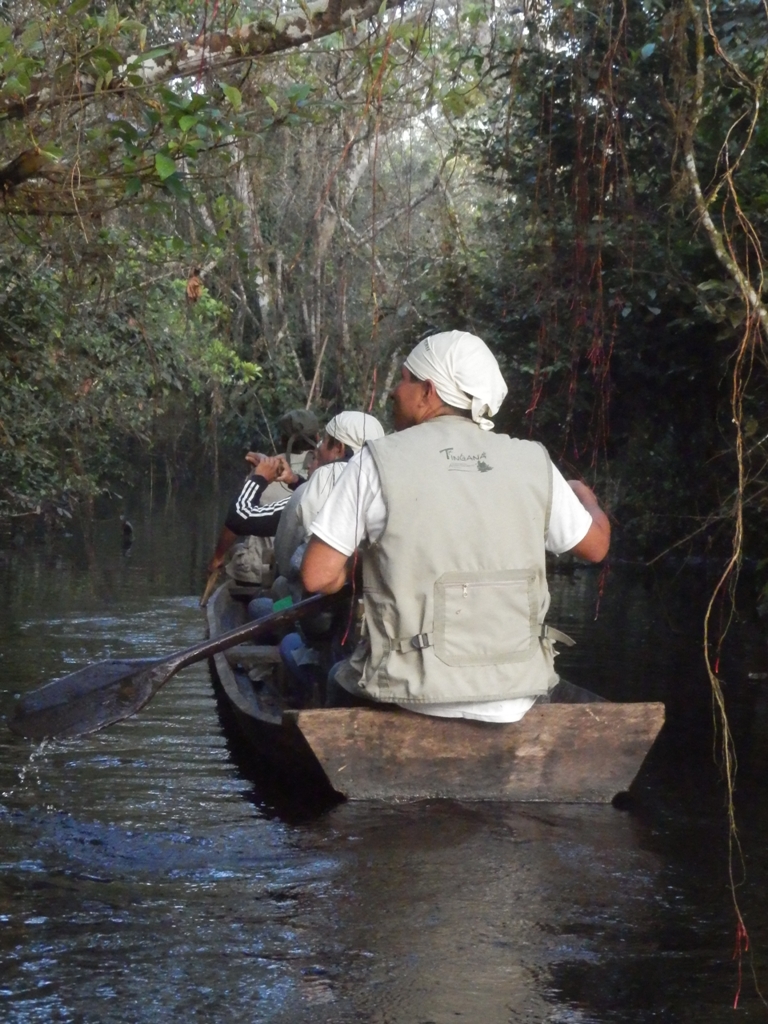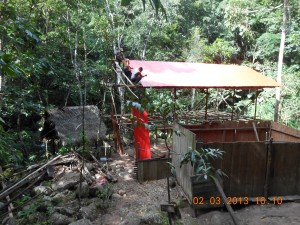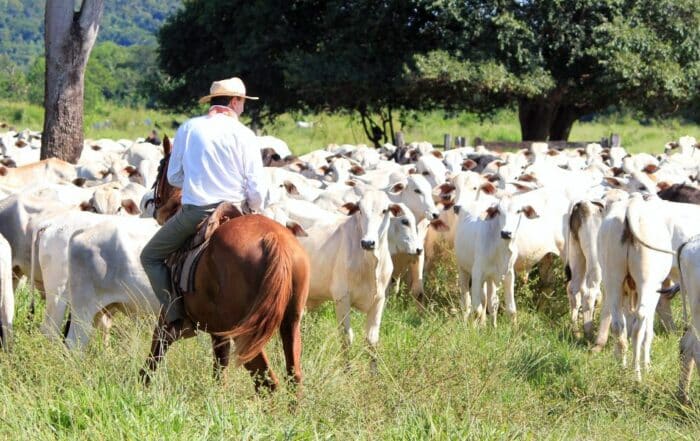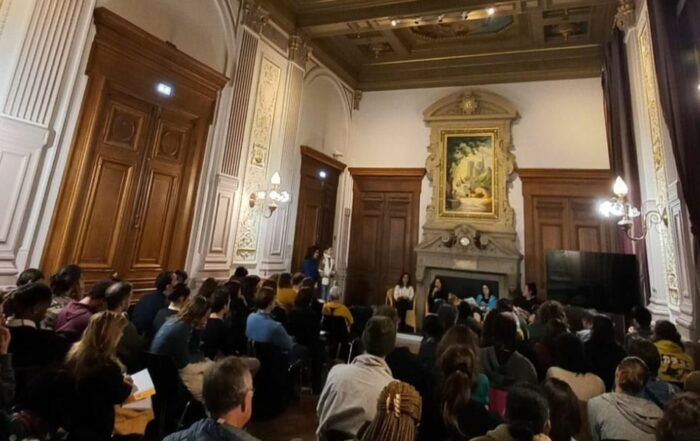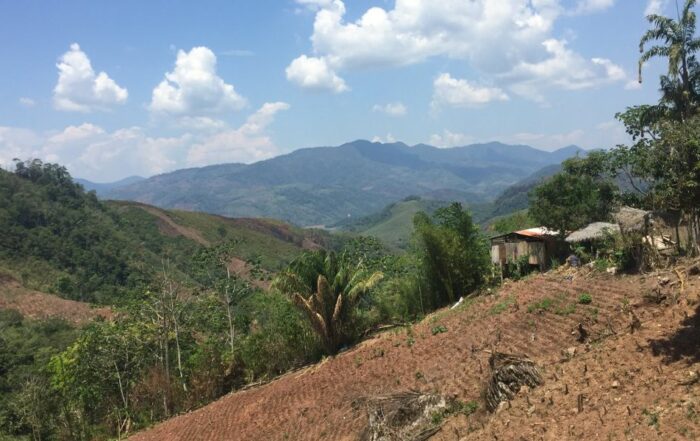May 2015:
This month, the Ecotourism project welcomes Leni Reulens, a new volunteer in the field!
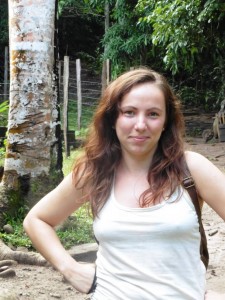 The rainy season is coming to an end and ecotourism activities are set to get busy again in Alto Shilcayo. 21-Year-old Leni Reulens arrived to work on the project in early May, ready for four months in the field. She will be joined in early June by Flora Goldgran to strengthen the financial and organisational viability of the ecotourism project.
The rainy season is coming to an end and ecotourism activities are set to get busy again in Alto Shilcayo. 21-Year-old Leni Reulens arrived to work on the project in early May, ready for four months in the field. She will be joined in early June by Flora Goldgran to strengthen the financial and organisational viability of the ecotourism project.
With a strong interest in alternatives to the conventional economy, she has decided to devote herself to projects with a more human and ecological focus. After a university diploma in marketing techniques in Bordeaux, she went on to study a degree in international trade, with a specialisation in fair trade, in Clermont Ferrand. To make use of her knowledge while staying true to her own values, she decided to get involved with Envol Vert projects, working out in the field.
Leni’s task is to consolidate the bases of the APFF association and ensure successful promotion of their tourist activity. Alongside her future partner Flora, one of her priorities will be to conceive and implement a business model for the association. She will also take part in the association’s daily activities and oversee progress with the hummingbird garden.
Leni has made a clear commitment to the association to help its members move forward and work towards their goals to recover and promote biodiversity in the Cordillera Escalera area.
April 2015
A new team and new strategic focus
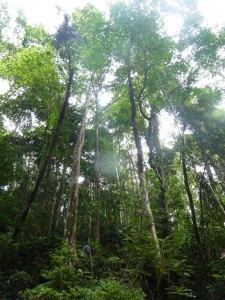 The Ecotourism in the Amazon in Peru project is nearly four years old. It is one of Envol Vert’s longest-standing projects and no fewer than 10 field volunteers have contributed to its progress.
The Ecotourism in the Amazon in Peru project is nearly four years old. It is one of Envol Vert’s longest-standing projects and no fewer than 10 field volunteers have contributed to its progress.
It is now moving into a new phase. After the implementation of a set of tools designed to promote ecotourism, then the development of biodiversity conservation projects in Alto Shilcayo, the various stakeholders in the project have decided to take a step back and think about its future.
Despite considerable progress, proven environmental protection and a formalised framework for the APFF association, it is now important that the project is strengthened further to make it economically and socially viable for the long term.
In order to rise to this challenge, some new focus areas have been defined for the project. A business model should be introduced in the coming months to consolidate the tourist activity and the structure of APFF.
The aim is to strengthen the intrinsic link between ecotourism and the introduction of forest conservation projects, the first providing funding for the second, without which no tourist activity would be possible at all.
Leni Reulens and Flora Goldgran, the two new field volunteers, will work together to develop the tools required to reinforce the project’s financial and organisational viability. They will be assisted by Lisa Mimoun, Envol Vert’s project coordinator, and Baptiste Flandre, a volunteer in France who is well familiar with the tourist sector in Peru.
September 2014
Ornithological training
In July 2014, we told you about the creation of a Hummingbird Garden, the new tourist activity from APFF. The flowers are now growing while members are being trained how to recognise plants and birds.
The training is being run by Henry Gonzales, an ornithologist and specialist in fauna. The members are delighted to be learning new things and are highly attentive to the specialist’s explanations. Henry not only provides theoretical knowledge but also gives practical advice with role plays on how to greet tourists as part of the training for the APFF guides.
August 2014
Inspection and monitoring activities, one year on
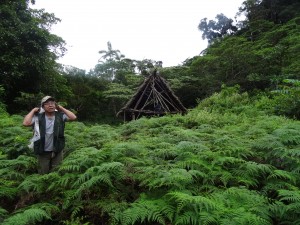 The Association for the Protection of Fauna and Flora (APFF) is continuing with its inspection and monitoring programme introduced just under a year ago and has just carried out its fifth inspection this August. The programme is designed to track evolution in biodiversity, human activity and its impact on ecosystems, in order to determine the level of conservation within a protected area. The goal is to incorporate a conservation activity, through field visits carried out by the association’s forest rangers since the time of its foundation, to report any environmental crime to the authorities and to carry out an inventory of the fauna and flora.
The Association for the Protection of Fauna and Flora (APFF) is continuing with its inspection and monitoring programme introduced just under a year ago and has just carried out its fifth inspection this August. The programme is designed to track evolution in biodiversity, human activity and its impact on ecosystems, in order to determine the level of conservation within a protected area. The goal is to incorporate a conservation activity, through field visits carried out by the association’s forest rangers since the time of its foundation, to report any environmental crime to the authorities and to carry out an inventory of the fauna and flora.
The outcome of the first five inspections, with a total of eight planned, is the recovery of sectors previously degraded by agricultural and illegal activity.
Thanks to the financial reward earned by the forest rangers, these twice-monthly activities form a genuine sustainable development project enabling not only the protection and conservation of the forest, but also the recognition of the forest rangers’ knowledge and work and an improvement in their living standards.
July 2014
Creation of a hummingbird garden
After witnessing biodiversity loss, the association APFF decided to recreate the habitat of 14 species of the Amazon’s emblematic hummingbirds, including Koepcke’s Hermit, a bird native to the region of San Martin, on two abandoned farming plots. This garden of heliconia, ginger and bromelia flowers, which will be ready in nine months’ time, will enable scientific work on the hummingbird and its environment while helping to rehabilitate an area previously subject to deforestation. The garden has been created by members of APFF with help from Henry Gonzalez, an ornithologist and fauna specialist. The profits from tourist activity at the site and Envol Vert’s remuneration of the APFF members for creating the garden will ensure the project is profitable.
June 2014
A website for APFF
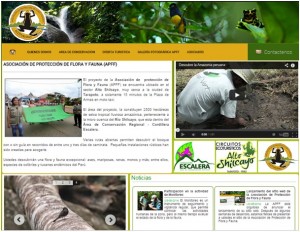 After a few long weeks of work by the team, APFF now has its own website. Thanks to a network of contacts, Isabelle, Envol Vert’s volunteer, was put in touch with webdesigner Samuel, who was willing to lend a hand and build the association’s website.
After a few long weeks of work by the team, APFF now has its own website. Thanks to a network of contacts, Isabelle, Envol Vert’s volunteer, was put in touch with webdesigner Samuel, who was willing to lend a hand and build the association’s website.
It is a clear, simple but dynamic website designed to promote the Cordillera Escalera Alto Shilcayo conservation area’s ecotourism offering as widely as possible, and includes information on APFF’s activities designed to conserve, protect and rehabilitate biodiversity.
>>>Take a look for yourself!<<<
May 2014:
Training with the Tingana community
 The San Martin regional department for foreign trade and tourism (DIRCETUR) has funded training in tourism for APFF members. This took place within the Tingana community, an example of successful forest conservation and ecotourism.
The San Martin regional department for foreign trade and tourism (DIRCETUR) has funded training in tourism for APFF members. This took place within the Tingana community, an example of successful forest conservation and ecotourism.
The Tingana community endeavours to conserve and rehabilitate the wetlands in Alto Mayo (region in San Martin) and to develop ecotourism in the flooded forest. The community was formed on 8 April 2003 and takes care of 3,479.73 hectares of flooded forest.
A two-day training session
A field visit was organised with participants staying overnight in tambos (wooden shacks) with a kitchen and dining room, a meeting room with a photo exhibition showing mammals from the area, ecological toilets and a rest area with hammocks. The discussions held were an opportunity to find out more about the Tingana community and to assess the strengths and weaknesses of APFF. APFF members also went out on a three-hour excursion to observe monkeys, anteaters, birds, butterflies and the local flora. www.tingana.org
The Tingana community gives off positive energy and is overflowing with creativity. Thanks to their support at these sessions, a whole host of new ideas has emerged among APFF members, such as reviewing the organisation of the association, finding allies for greater strength, increasing the number of training opportunities (recycling, organisation, wood sculpture, etc.), boosting motivation among members, creating new infrastructures with recovered materials, or offering better customer service.
A promising duo from France
 We are extremely excited about the arrival of Isabelle Dupin, who will be joining Lisa on the ecotourism project for the next six months, to form a very promising duo.
We are extremely excited about the arrival of Isabelle Dupin, who will be joining Lisa on the ecotourism project for the next six months, to form a very promising duo.
First and foremost, Isabelle is truly passionate about the forest, a sentiment that stems from her realisation that our lifestyles do not respect nature or other people, and that the only way to change behaviour is to take action. She started by changing her own approach to nature and people, then tried to raise awareness about responsible and ethical choices among her family and friends. Later, she felt the urge to join the ecotourism project to put her skills to use in the field and support the local population in their work to better protect the Amazon forest.
Isabelle has a university diploma in marketing techniques and a degree in marketing and sustainable development, as part of a sandwich course with a company focused on reforestation, Reforest’Action – 5 Continents. With a warm, attentive and dynamic personality, she will be working on the communication part of the project and the marketing of the tourist circuit, having gained experience in these areas in her career up to now.
April 2014:
Recent fieldwork
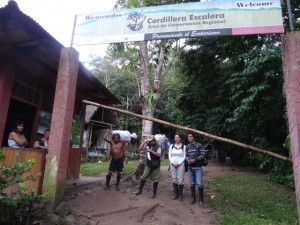 Thanks to funding from Envol Vert, APFF has benefited from training in ecotourism delivered by Rodrigo Galvão, a biologist specialising in these issues, with the aim of improving the welcome reserved for tourists by guides in the area and thus increasing the tourist potential available. The training session reiterated how important it is explain to tourists that they are not here to “consume” a product or visit a zoo, but that by paying a fair price, they become real stakeholders in a sustainable development project, helping to protect fauna and flora. The guides developed awareness that their job is to promote and share their knowledge, to raise environmental awareness.
Thanks to funding from Envol Vert, APFF has benefited from training in ecotourism delivered by Rodrigo Galvão, a biologist specialising in these issues, with the aim of improving the welcome reserved for tourists by guides in the area and thus increasing the tourist potential available. The training session reiterated how important it is explain to tourists that they are not here to “consume” a product or visit a zoo, but that by paying a fair price, they become real stakeholders in a sustainable development project, helping to protect fauna and flora. The guides developed awareness that their job is to promote and share their knowledge, to raise environmental awareness.
APFF members also proceeded with their third inspection and monitoring exercise (known as monitoreo), which includes an inventory of the existing fauna and flora and a review of how the zone is recovering. After two days’ walking in some harsh weather conditions, the guides reached the remote area of Cashiyacu where they were able to observe toucans, hummingbirds, frogs and traces of a jaguar and a bear. Their exploratory work will help APFF define the rehabilitation activities focusing on fauna in the area, whereby the guides’ knowledge and experience will be put to valuable use.
March 2014:
Lisa arrives and gets straight down to work
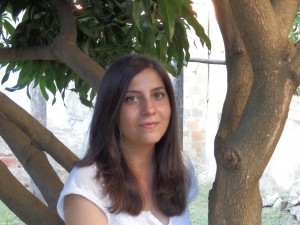 24-Year-old Lisa Mimoun has been in Tarapoto since early March. After completing a Master’s in history, specialising in contemporary development issues in the Brazilian Amazon, and currently studying for a Master’s in geography and sustainable development at the Sorbonne, she has decided to pursue her specialisation in this theme as a volunteer with Envol Vert.
24-Year-old Lisa Mimoun has been in Tarapoto since early March. After completing a Master’s in history, specialising in contemporary development issues in the Brazilian Amazon, and currently studying for a Master’s in geography and sustainable development at the Sorbonne, she has decided to pursue her specialisation in this theme as a volunteer with Envol Vert.
Lisa has worked to strengthen the association’s institutional relations by mediating in a conflict over the reduction of the association’s area of action imposed by the regional government (PEH): she attended information meetings on the zone’s reorganisation and presented leaders from the PEH with an exposé on the work done with APFF since 2011 and its achievements. Finally, she has supported APFF in all their activities and is currently working to organise a wildlife recovery project with the planting of certain species of trees and plants.
Lisa is still just as enthusiastic and willing to help APFF members, and continues to work towards what is, for her, a real human and intellectual adventure.
November 2013:
Presentation of the Suchiche Café project
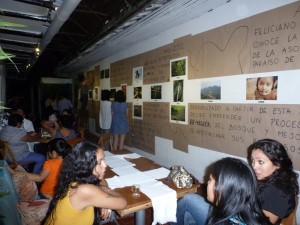 The ecotourism project run by APFF (Association to Protect Fauna and Flora) is still relatively unknown among the local population. After talking it over with Martin, who manages the Suchiche cultural café, Aline, project volunteer, offered to give a presentation of APFF to raise awareness of the project and give it a boost.
The ecotourism project run by APFF (Association to Protect Fauna and Flora) is still relatively unknown among the local population. After talking it over with Martin, who manages the Suchiche cultural café, Aline, project volunteer, offered to give a presentation of APFF to raise awareness of the project and give it a boost.
He was more than willing to accept and so they set to work to organise the event, including a photo exhibition showing the association’s history and achievements, short film shows, a game on smells associated with the jungle, and much more – all in a forest-style setting, under the watchful eye of a “wish tree” where visitors could hang their wishes for nature.
There was a comprehensive communication plan, including written invitations, a Facebook event and posters. In the end, the café was chock-full! It was a chance for APFF members to meet new people interested in the project as well as other NGOs. For example, a representative from Cuso International took an interest and expressed the wish to make the project a beneficiary of their funding. From among all the people in attendance that evening, we hope other new opportunities will come to light. What is more, the event was highly positive for APFF members who were able to say what they think and to see that people could be drawn in, something that gave them a real boost for future action.
October 2013:
The association’s forest rangers carry out their first inspection
From 22 to 25 October, four members of the association went out on “guard duty” to do some identification work in the Cachiyaca sector, the most remote area of their catchment.
In addition to their inspection work, this was an opportunity to list the plants and animals encountered on their way. They observed frogs, endemic bird species, snakes, tapirs and, thanks to footprints and broken palm branches, detected the presence of the spectacled bear. No human or illegal (hunting, deforestation, land sale) activity was recorded. The members came back with some valuable data and the satisfaction of seeing that, after years of work, the site was gradually returning to its natural state. Future visits are set to be more even more effective as the members will be able to use better equipment and new tools, funded by SODEXO. This includes a camera with HD video function, night-vision binoculars, sound recorder and sat-nav equipment, and will help them make the most of their field visits and new awareness-raising actions among the local population.
Sodexo strengthened its commitment to Envol Vert’s Ecotourism in the Amazon in Peru project.
 In early 2013, Sodexo and its in-house challenge “Save the trees” set the goal of reducing paper use by 20% across its Benefits and Rewards department in all its entities. To step up its action, Sodexo decided to help Envol Vert by funding the Conservation element of the “Ecotourism in the Amazon in Peru” project.
In early 2013, Sodexo and its in-house challenge “Save the trees” set the goal of reducing paper use by 20% across its Benefits and Rewards department in all its entities. To step up its action, Sodexo decided to help Envol Vert by funding the Conservation element of the “Ecotourism in the Amazon in Peru” project.
The first donation was thus used to fund the environmental diagnosis in the Alto Shilcayo zone and the action plan for its conservation, as well as the introduction of community patrols. Find out more about this project.
Sodexo has now reached – and indeed surpassed – its goal for the “Save the trees” challenge as, after just 9 months, paper use (management processes, including invoices and in-house printing) has been reduced by 25% in the 19 countries taking part in the challenge! This means a total of around 10,500 sheets of paper saved, or 660 trees!
To celebrate this excellent achievement, Sodexo has renewed its commitment to Envol Vert and the Ecotourism in the Amazon project. This will help Envol Vert buy new technical equipment for the patrols, make regular inventories of fauna and flora and to carry out operations to encourage a return to biodiversity.
July 2013:
An environmental diagnosis to strengthen the association
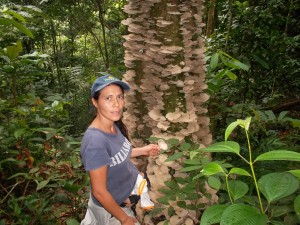 Thanks to a donation from SODEXO, Envol Vert has been able to fund the environmental diagnosis of APFF’s catchment area. This diagnosis is a major step forward for the association which, until now, had no real study available to form a basis for its work. The members took part in the diagnosis (meetings and field visits) and are delighted that they now have the information they need to back their applications to various institutions.
Thanks to a donation from SODEXO, Envol Vert has been able to fund the environmental diagnosis of APFF’s catchment area. This diagnosis is a major step forward for the association which, until now, had no real study available to form a basis for its work. The members took part in the diagnosis (meetings and field visits) and are delighted that they now have the information they need to back their applications to various institutions.
The diagnosis defines the area (situation, climate, geology, etc.) and gives a view of the rich biodiversity (waterfalls, medicinal plants, fauna, flora, etc.) but also its vulnerability.
It insists on the importance of introducing strategies: – to conserve water which supplies part of the town – to protect local fauna by, for example, setting apart areas to protect the harlequin frog, threatened with extinction, or to plant species such as heliconias to bring back certain birds, such as the hummingbird.
Top-level recognition
 APFF has entered two contests. It has submitted a video for the 9th INKAFEST competition, a film festival devoted to nature and the mountains taking place from 23 to 31 August in Huaraz. We are still waiting for the results…
APFF has entered two contests. It has submitted a video for the 9th INKAFEST competition, a film festival devoted to nature and the mountains taking place from 23 to 31 August in Huaraz. We are still waiting for the results…
APFF also took part in the 2013 National Awards for Ecological Citizenship, run by the Ministry of Environment. APFF was among the finalists and now benefits from national-level recognition of its work with the diploma it received. Envol Vert funded APFF’s trip to Lima on 16 July for the awards ceremony, where APFF’s president Feliciano was able to shake hands with Environment Minister Manuel Pulgar.
At a meeting organised by association members, four of them expressed their emotion over this recognition from the State. It is very promising for the association which now has new-founded confidence in itself and its abilities. There is renewed motivation and enthusiasm among members for the association’s future.
Finally last week, the association was involved in a local, one-hour long Peruvian TV programme. Members took journalists out on one of the ecotourist routes offered by the association, to see the Tamaushal waterfall.
June 2013:
A new volunteer welcomed to the Amazon forest
 25-Year-old Aline, holder of a Master’s in humanitarian project management and cultural development, arrived in Tarapoto in early July to support the local association for the protection of fauna and flora (APFF), backed by Envol Vert.
25-Year-old Aline, holder of a Master’s in humanitarian project management and cultural development, arrived in Tarapoto in early July to support the local association for the protection of fauna and flora (APFF), backed by Envol Vert.
A few years ago, she developed an interest in a more responsible form of tourism applying sustainable development principles, and so enthusiastically signed up for the ecotourism project to help stop deforestation in this highly vulnerable area.
Aline’s job will be to coordinate the project in the field and report back important information to Envol Vert to ensure thorough monitoring. As soon as she arrived, she was put in charge of the environmental diagnosis funded by the partnership with SODEXO. She has already attended a number of meetings. She is also responsible for alleviating the tensions felt between certain associations and institutions to encourage better relationships and mutual respect. Finally, APFF is preparing for a contest organised by the San Martin region. Aline will be able to share her experience to help draft the application for this call for funds for the actions planned for the next five years.
April 2013:
New signposts along the track
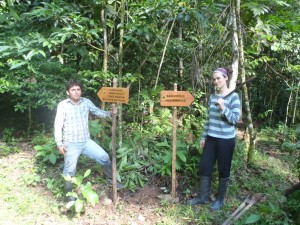 The Association for the Protection of Fauna and Flora (APFF), backed by Envol Vert, has produced 9 new signposts for the area. These signs will improve the quality of the tourist circuit on offer and help make the activity more professional. The signs are made from wood and will provide better information for visitors, with little impact on the environment.
The Association for the Protection of Fauna and Flora (APFF), backed by Envol Vert, has produced 9 new signposts for the area. These signs will improve the quality of the tourist circuit on offer and help make the activity more professional. The signs are made from wood and will provide better information for visitors, with little impact on the environment.
March 2013:
A partnership with Sodexo to protect the forest
 French firm Sodexo, world leader for quality of life services, has joined up with Envol Vert to help protect the Amazon forest. Their financial contribution will help the association in charge of protection in the area carry out an environmental diagnosis to demonstrate the area’s importance in terms of biodiversity, and define the protection actions to be implemented as a priority.
French firm Sodexo, world leader for quality of life services, has joined up with Envol Vert to help protect the Amazon forest. Their financial contribution will help the association in charge of protection in the area carry out an environmental diagnosis to demonstrate the area’s importance in terms of biodiversity, and define the protection actions to be implemented as a priority.
A new welcome area under construction!
Photo credit: Juver Tuanama
The association’s members are currently working to improve tourist accommodation capacity in the area. Things are going well so far. The building is made of environmentally-friendly materials only and is set to be inaugurated in early April.
February 2013:
Posters all around the town of Tarapoto
The Association for the Protection of Fauna and Flora (APFF) has produced posters to promote the ecotourist circuits around Alto Shilcayo, to increase communication about the project. These posters will be distributed in tourist offices, hotels and bus stations at tourist spots in the town. The arrival of Carole, a new volunteer, will help further improve communication around the project among tourists and inhabitants in Tarapoto.
November 2012:
A new welcome area!
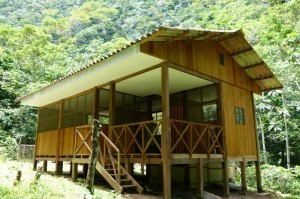 The Huallaga project (regional organisation in charge of protection in the area) is building a high-quality guest house in the area, meaning the association will be able to accommodate tourists for one or several nights in a secure, comfortable place, just a stone’s throw from the waterfalls. The first visitors will appreciate the comfort on offer after a long day’s walk.
The Huallaga project (regional organisation in charge of protection in the area) is building a high-quality guest house in the area, meaning the association will be able to accommodate tourists for one or several nights in a secure, comfortable place, just a stone’s throw from the waterfalls. The first visitors will appreciate the comfort on offer after a long day’s walk.
October 2013:
Communication action and visitor numbers are increasing
![[ECOTOUR]Groupe Touristes1.©APFF](http://envol-vert.org/wp-content/uploads/2012/03/ECOTOURGroupe-Touristes1.©APFF-225x300.jpg) The arrival of new volunteer Antoine in October has made it possible to reach out to a large number of tourist agencies to promote the site and offer them tourist packages of one to three days at a set price. All these agencies were interested in this new destination located near the town and includes outings into the forest to see the waterfalls, a number of viewpoints and to discover the biodiversity.
The arrival of new volunteer Antoine in October has made it possible to reach out to a large number of tourist agencies to promote the site and offer them tourist packages of one to three days at a set price. All these agencies were interested in this new destination located near the town and includes outings into the forest to see the waterfalls, a number of viewpoints and to discover the biodiversity.
The teaser video created by Envol Vert and shown during the agency visits made a great impact. In addition, the new leaflets were reprinted and distributed in the agencies or during events focusing on nature conservation. Envol Vert and APFF, (Association for the Protection of Fauna and Flora) took part in a number of nature festivals in the capital, Lima, and made several contacts with journalists.
These actions, which began a few months ago, have been effective in increasing visitor numbers with an almost three-fold rise between 2010 and 2011. In fact, by July 2012, we had already equalled the total number of visits recorded in 2011.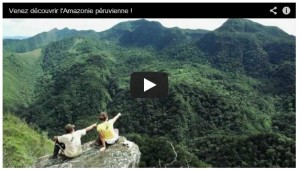
September 2012:
Equipment for greater professionalism
![[ECOTOUR]Miembros de la APFF.©D.Tarrier](http://envol-vert.org/wp-content/uploads/2012/03/ECOTOURMiembros-de-la-APFF.©D.Tarrier-300x200.jpg) Thanks to its donors’ generosity, Envol Vert has been able to purchase new equipment including tents, boots, headlamps, ropes and binoculars. This equipment can be hired to provide greater comfort for visitors coming to the area. Safety has also been greatly improved with the purchase of ropes for the steeper tracks and emergency medicines for first aid during hikes. Insurance has also been taken out to cover visitors. A motorbike has also been purchased to make it easier for association members to travel to the entrance to the tourist area. Finally, a laptop computer and internet connection has been granted to improve communication as part of tourist promotion work in the area.
Thanks to its donors’ generosity, Envol Vert has been able to purchase new equipment including tents, boots, headlamps, ropes and binoculars. This equipment can be hired to provide greater comfort for visitors coming to the area. Safety has also been greatly improved with the purchase of ropes for the steeper tracks and emergency medicines for first aid during hikes. Insurance has also been taken out to cover visitors. A motorbike has also been purchased to make it easier for association members to travel to the entrance to the tourist area. Finally, a laptop computer and internet connection has been granted to improve communication as part of tourist promotion work in the area.
Stronger relations with the institutions
![[ECOTOUR]reunion2©L.Durant](http://envol-vert.org/wp-content/uploads/2012/03/ECOTOURreunion2©L.Durant-300x200.jpg) The regional tourism department (DIRCETUR) has spent time offering support for APFF’s development in the form of training and promotion. A training programme has been designed to teach members and guides more about good environmental practices and natural and cultural heritage, and to improve their English. Regular meetings are held with government structures or local associations to build up collaborative relationships and share ideas. A cooperation agreement has been signed between APFF, ENVOL VERT and local NGO, CEDISA. An increasing number of institutions are taking an interest in our work and offering support. For example, engineers were recently sent to look into the possibility of building small structures (such as bridges) and improving mobility at the site.
The regional tourism department (DIRCETUR) has spent time offering support for APFF’s development in the form of training and promotion. A training programme has been designed to teach members and guides more about good environmental practices and natural and cultural heritage, and to improve their English. Regular meetings are held with government structures or local associations to build up collaborative relationships and share ideas. A cooperation agreement has been signed between APFF, ENVOL VERT and local NGO, CEDISA. An increasing number of institutions are taking an interest in our work and offering support. For example, engineers were recently sent to look into the possibility of building small structures (such as bridges) and improving mobility at the site.
The current situation is highly positive: the association is growing rapidly and the forest that it protects will be well preserved if we carry on like this. APFF members are no longer alone and the commitment to protecting the forest is really starting to show some results. Envol Vert is proud to be contributing to this on a daily basis.
July 2012:
English lessons and an action plan
![[ECOTOUR]Carolina au travail 204©C.Cubas](http://envol-vert.org/wp-content/uploads/2012/03/ECOTOURCarolina-au-travail-204©C.Cubas_-300x225.jpg) Carolina from Peru and Arnaud, a Frenchman living in Peru, have come to share their views, experience and know-how with English lessons for association members greeting tourists and help in developing an action plan to improve organisation.
Carolina from Peru and Arnaud, a Frenchman living in Peru, have come to share their views, experience and know-how with English lessons for association members greeting tourists and help in developing an action plan to improve organisation.
A meeting was also held with inhabitants in the area to share their fears and wishes with regard to local development and the ecotourism project, to make sure that everyone’s interests are heard and respected.
This has all helped the project make good progress and benefit from the recognition of the local authorities, with whom we work very closely.
June 2012:
A woodworker on the project
![[EQUIPE]Arnaud et guillaume©C.Cubas](http://envol-vert.org/wp-content/uploads/2012/03/EQUIPEArnaud-et-guillaume©C.Cubas_-300x225.jpg) Guillaume, who arrived mid-April, has taken over from Pauline and Bérengère. He is a trained cabinetmaker and will be providing the association with support to improve infrastructures and secure paths.
Guillaume, who arrived mid-April, has taken over from Pauline and Bérengère. He is a trained cabinetmaker and will be providing the association with support to improve infrastructures and secure paths.
A new shelter is being refurbished to give hikers somewhere to rest or eat, against an idyllic background just before the Tamushal waterfalls. In addition, a box has been made and placed at the reception area so visitors can leave a donation!
A party to promote the site
![[ECOTOUR]Fete San Juan 5©G.Allamelou](http://envol-vert.org/wp-content/uploads/2012/03/ECOTOURFete-San-Juan-5©G.Allamelou-197x300.jpg) At the time of the San Juan festival, a party was held on 9 June for a hundred or so people from the local tourist sector.
At the time of the San Juan festival, a party was held on 9 June for a hundred or so people from the local tourist sector.
There was music, dancing, chicha (a local drink) and a visit up to the Tamushal waterfalls, with great company and plenty of sunshine! This all helped increase awareness of the site and promote the ecotourist circuits. The celebrations continued with the official introduction of the new price policy put forward by the Asociacion de Proteccion Fauna y Flora.
Partnerships in the pipeline
The partnership with the Tourist Ministry is taking shape, after the contacts made a few weeks ago with regard to the funding for a number of small infrastructure elements. After an initial visit, the Minister will come to a meeting next July and will carry out a feasibility study ahead of a response to be issued during the summer. While this financial support is a major issue for APFF, the association will continue to develop its network of partners, in particular with the Tarapoto town council.
April 2012:
A new tourist policy
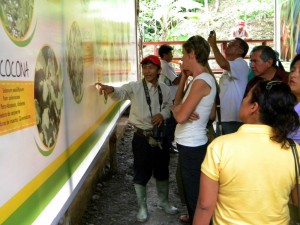 Two new volunteers, Bérengère and Pauline have been working on the tourist strategy and defining a new price policy. The tourist strategy includes the identification of a number of attractive tourist circuits suitable for all types of visitor. It also means defining a more relevant price policy so that APFF members are able to make a decent living. To this end, a clear pitch was submitted to the administrative body in charge of the area, the Huayaga Special Project, reporting to the San Martin region; this was eventually accepted.
Two new volunteers, Bérengère and Pauline have been working on the tourist strategy and defining a new price policy. The tourist strategy includes the identification of a number of attractive tourist circuits suitable for all types of visitor. It also means defining a more relevant price policy so that APFF members are able to make a decent living. To this end, a clear pitch was submitted to the administrative body in charge of the area, the Huayaga Special Project, reporting to the San Martin region; this was eventually accepted.
The volunteers are also tasked with consolidating the local association in institutional and legal terms.
A new leaflet and a Facebook page
 To promote the new circuits and improve awareness of the project and the tourist circuits among agencies and tourists, a new promotional leaflet has been printed and distributed. The Tourist Department also contributed to the operation and the printing work. A Facebook page has also been set up to share visitor information with friends and followers: “APFF – Asociación de Protección de “Flora y Fauna”
To promote the new circuits and improve awareness of the project and the tourist circuits among agencies and tourists, a new promotional leaflet has been printed and distributed. The Tourist Department also contributed to the operation and the printing work. A Facebook page has also been set up to share visitor information with friends and followers: “APFF – Asociación de Protección de “Flora y Fauna”
In addition, the volunteers have helped with the installation of signs so that tourists are able to find their way to the Tamushal waterfall, located 3 km from the reception booth, and have done a number of jobs to provide day-to-day support to APFF.
March 2012:
New infrastructures
Thanks to an agreement with the NGO ECOAN and APFF (Asociación de Protección Flora y Fauna), the local operator managing the Alto Shilcayo protection area, a tourist reception booth has been built at the entrance to the reserve, while a building devoted to local fauna and flora, an educational resource for tourists and school groups, has been renovated. Similarly, a “bird route” has been developed to boost the local economy. This route passes through the project area and three guides, association members, have been specially trained.
Finally, the paths have been serviced to improve access to the site and in September a botanical garden, including several native and medicinal species, was planted.
An agreement signed with the Lamas community
![[ECOTOUR]femme_llamiste©L.Durant](http://envol-vert.org/wp-content/uploads/2012/03/ECOTOURfemme_llamiste©L.Durant-200x300.jpg) The Lamas community is based in a village located 10 km from the town of Tarapoto, but they own farms in the heart of the conservation area managed by APFF. Our visit in August 2011 led to the first formal meeting between the Lamas community and APFF. A second meeting was held on 28 January 2012. The two parties decided to sign a cooperation agreement and undertook to provide mutual support for activities designed to protect and conserve animal and plant species in the area.
The Lamas community is based in a village located 10 km from the town of Tarapoto, but they own farms in the heart of the conservation area managed by APFF. Our visit in August 2011 led to the first formal meeting between the Lamas community and APFF. A second meeting was held on 28 January 2012. The two parties decided to sign a cooperation agreement and undertook to provide mutual support for activities designed to protect and conserve animal and plant species in the area.
Community members agreed to keep APFF informed before embarking on any activity likely to affect the ecological balance and both signatories agreed to help each other for activities such as improving access or renovating structures. In the long term, this agreement will help the community, already very open to the outside world, to meet tourists and share their customs and crafts with them.
February 2012:
Two volunteers active in the field
![[EQUIPE]Bérengère et Pauline©B.Fevrier](http://envol-vert.org/wp-content/uploads/2012/03/EQUIPEBérengère-et-Pauline©B.Fevrier-300x225.jpg) 25-Year-old Bérengère and 27-year-old Pauline, graduates from ISCOM school in Paris, with a Master’s in Communication, and from IEP school in Lyon, specialising in “regional sustainable development policies”, arrived on the project in February 2012. For them, signing up to the Ecotourism in the Amazon in Peru came quite naturally, as it is a project that combines both environmental and social issues. Their job will be to form a development strategy, create and implement communication tools and coordinate with the local and national authorities.
25-Year-old Bérengère and 27-year-old Pauline, graduates from ISCOM school in Paris, with a Master’s in Communication, and from IEP school in Lyon, specialising in “regional sustainable development policies”, arrived on the project in February 2012. For them, signing up to the Ecotourism in the Amazon in Peru came quite naturally, as it is a project that combines both environmental and social issues. Their job will be to form a development strategy, create and implement communication tools and coordinate with the local and national authorities.
The cultural wealth and their immersion in a new country will give them the chance to acquire new project management and coordination skills.
December 2011:
Project Video
Thanks to Léa’s work during the summer 2011 mission, a video presenting the project and its challenges has been produced in French and Spanish and made available to association members.
July 2011:
Making contact
On 28 July 2011, Envol Vert met with members of the Association for the Protection of Fauna and Flora (APFF) in Tarapoto, Peru. Around ten people – members and volunteers from the association – were present.
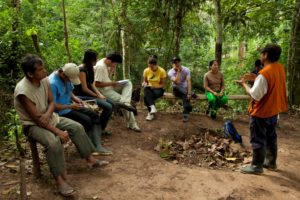 This meeting was a chance to review the association’s current actions and talk about future projects that members are hoping to develop.
This meeting was a chance to review the association’s current actions and talk about future projects that members are hoping to develop.
For decades, the Alto Shilcayo watershed area was used by populations involved in migratory farming, illegal wood felling and the hunting of wild animals, all particularly destructive activities. More than a hundred people, including farmers and several families from the indigenous Lamas community, lived in the area. A number of farmers realised the negative impact their activity was having and founded the APFF in 2003. The association’s goal is to conserve and protect the Alto Shilayo area by raising the population’s awareness. and developing sustainable activities generating revenue.
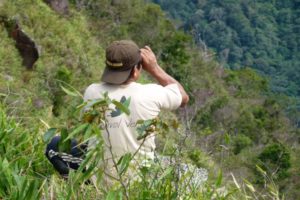 At the meeting, it became clear that not all users yet have the necessary awareness and, above all, that the ecotourism activity lacks a strategy and thus does not enable inhabitants to enjoy real alternative economic benefits that would guarantee protection of the forest.
At the meeting, it became clear that not all users yet have the necessary awareness and, above all, that the ecotourism activity lacks a strategy and thus does not enable inhabitants to enjoy real alternative economic benefits that would guarantee protection of the forest.
As such, members are looking to develop promotion of the area and improve a number of smaller infrastructure elements, mainly as a matter of security. They would also like to offer tourists themed visits (such as a self-guided walk, bird-watching, 3-day discovery visit or botanical garden). In addition, at the meeting, they expressed their interest in defining a conservation plan and carrying out an environmental diagnosis to determine how to implement their activities (reforestation, reintroduction of species, and so on).
During our three-day hike to visit the area, we were able to see for ourselves that farming activities in the area had become extremely limited and that areas previously deforested for farming were now recovering.
We were also able to meet local tourists, accompanied by the association’s guides, there to enjoy the waterfalls and the wonderful, unspoilt natural setting.
May 2015:
This month, the Ecotourism project welcomes Leni Reulens, a new volunteer in the field!
 The rainy season is coming to an end and ecotourism activities are set to get busy again in Alto Shilcayo. 21-Year-old Leni Reulens arrived to work on the project in early May, ready for four months in the field. She will be joined in early June by Flora Goldgran to strengthen the financial and organisational viability of the ecotourism project.
The rainy season is coming to an end and ecotourism activities are set to get busy again in Alto Shilcayo. 21-Year-old Leni Reulens arrived to work on the project in early May, ready for four months in the field. She will be joined in early June by Flora Goldgran to strengthen the financial and organisational viability of the ecotourism project.
With a strong interest in alternatives to the conventional economy, she has decided to devote herself to projects with a more human and ecological focus. After a university diploma in marketing techniques in Bordeaux, she went on to study a degree in international trade, with a specialisation in fair trade, in Clermont Ferrand. To make use of her knowledge while staying true to her own values, she decided to get involved with Envol Vert projects, working out in the field.
Leni’s task is to consolidate the bases of the APFF association and ensure successful promotion of their tourist activity. Alongside her future partner Flora, one of her priorities will be to conceive and implement a business model for the association. She will also take part in the association’s daily activities and oversee progress with the hummingbird garden.
Leni has made a clear commitment to the association to help its members move forward and work towards their goals to recover and promote biodiversity in the Cordillera Escalera area.
April 2015
A new team and new strategic focus
 The Ecotourism in the Amazon in Peru project is nearly four years old. It is one of Envol Vert’s longest-standing projects and no fewer than 10 field volunteers have contributed to its progress.
The Ecotourism in the Amazon in Peru project is nearly four years old. It is one of Envol Vert’s longest-standing projects and no fewer than 10 field volunteers have contributed to its progress.
It is now moving into a new phase. After the implementation of a set of tools designed to promote ecotourism, then the development of biodiversity conservation projects in Alto Shilcayo, the various stakeholders in the project have decided to take a step back and think about its future.
Despite considerable progress, proven environmental protection and a formalised framework for the APFF association, it is now important that the project is strengthened further to make it economically and socially viable for the long term.
In order to rise to this challenge, some new focus areas have been defined for the project. A business model should be introduced in the coming months to consolidate the tourist activity and the structure of APFF.
The aim is to strengthen the intrinsic link between ecotourism and the introduction of forest conservation projects, the first providing funding for the second, without which no tourist activity would be possible at all.
Leni Reulens and Flora Goldgran, the two new field volunteers, will work together to develop the tools required to reinforce the project’s financial and organisational viability. They will be assisted by Lisa Mimoun, Envol Vert’s project coordinator, and Baptiste Flandre, a volunteer in France who is well familiar with the tourist sector in Peru.
September 2014
Ornithological training
In July 2014, we told you about the creation of a Hummingbird Garden, the new tourist activity from APFF. The flowers are now growing while members are being trained how to recognise plants and birds.
The training is being run by Henry Gonzales, an ornithologist and specialist in fauna. The members are delighted to be learning new things and are highly attentive to the specialist’s explanations. Henry not only provides theoretical knowledge but also gives practical advice with role plays on how to greet tourists as part of the training for the APFF guides.
August 2014
Inspection and monitoring activities, one year on
 The Association for the Protection of Fauna and Flora (APFF) is continuing with its inspection and monitoring programme introduced just under a year ago and has just carried out its fifth inspection this August. The programme is designed to track evolution in biodiversity, human activity and its impact on ecosystems, in order to determine the level of conservation within a protected area. The goal is to incorporate a conservation activity, through field visits carried out by the association’s forest rangers since the time of its foundation, to report any environmental crime to the authorities and to carry out an inventory of the fauna and flora.
The Association for the Protection of Fauna and Flora (APFF) is continuing with its inspection and monitoring programme introduced just under a year ago and has just carried out its fifth inspection this August. The programme is designed to track evolution in biodiversity, human activity and its impact on ecosystems, in order to determine the level of conservation within a protected area. The goal is to incorporate a conservation activity, through field visits carried out by the association’s forest rangers since the time of its foundation, to report any environmental crime to the authorities and to carry out an inventory of the fauna and flora.
The outcome of the first five inspections, with a total of eight planned, is the recovery of sectors previously degraded by agricultural and illegal activity.
Thanks to the financial reward earned by the forest rangers, these twice-monthly activities form a genuine sustainable development project enabling not only the protection and conservation of the forest, but also the recognition of the forest rangers’ knowledge and work and an improvement in their living standards.
July 2014
Creation of a hummingbird garden
After witnessing biodiversity loss, the association APFF decided to recreate the habitat of 14 species of the Amazon’s emblematic hummingbirds, including Koepcke’s Hermit, a bird native to the region of San Martin, on two abandoned farming plots. This garden of heliconia, ginger and bromelia flowers, which will be ready in nine months’ time, will enable scientific work on the hummingbird and its environment while helping to rehabilitate an area previously subject to deforestation. The garden has been created by members of APFF with help from Henry Gonzalez, an ornithologist and fauna specialist. The profits from tourist activity at the site and Envol Vert’s remuneration of the APFF members for creating the garden will ensure the project is profitable.
June 2014
A website for APFF
 After a few long weeks of work by the team, APFF now has its own website. Thanks to a network of contacts, Isabelle, Envol Vert’s volunteer, was put in touch with webdesigner Samuel, who was willing to lend a hand and build the association’s website.
After a few long weeks of work by the team, APFF now has its own website. Thanks to a network of contacts, Isabelle, Envol Vert’s volunteer, was put in touch with webdesigner Samuel, who was willing to lend a hand and build the association’s website.
It is a clear, simple but dynamic website designed to promote the Cordillera Escalera Alto Shilcayo conservation area’s ecotourism offering as widely as possible, and includes information on APFF’s activities designed to conserve, protect and rehabilitate biodiversity.
>>>Take a look for yourself!<<<
May 2014:
Training with the Tingana community
 The San Martin regional department for foreign trade and tourism (DIRCETUR) has funded training in tourism for APFF members. This took place within the Tingana community, an example of successful forest conservation and ecotourism.
The San Martin regional department for foreign trade and tourism (DIRCETUR) has funded training in tourism for APFF members. This took place within the Tingana community, an example of successful forest conservation and ecotourism.
The Tingana community endeavours to conserve and rehabilitate the wetlands in Alto Mayo (region in San Martin) and to develop ecotourism in the flooded forest. The community was formed on 8 April 2003 and takes care of 3,479.73 hectares of flooded forest.
A two-day training session
A field visit was organised with participants staying overnight in tambos (wooden shacks) with a kitchen and dining room, a meeting room with a photo exhibition showing mammals from the area, ecological toilets and a rest area with hammocks. The discussions held were an opportunity to find out more about the Tingana community and to assess the strengths and weaknesses of APFF. APFF members also went out on a three-hour excursion to observe monkeys, anteaters, birds, butterflies and the local flora. www.tingana.org
The Tingana community gives off positive energy and is overflowing with creativity. Thanks to their support at these sessions, a whole host of new ideas has emerged among APFF members, such as reviewing the organisation of the association, finding allies for greater strength, increasing the number of training opportunities (recycling, organisation, wood sculpture, etc.), boosting motivation among members, creating new infrastructures with recovered materials, or offering better customer service.
A promising duo from France
 We are extremely excited about the arrival of Isabelle Dupin, who will be joining Lisa on the ecotourism project for the next six months, to form a very promising duo.
We are extremely excited about the arrival of Isabelle Dupin, who will be joining Lisa on the ecotourism project for the next six months, to form a very promising duo.
First and foremost, Isabelle is truly passionate about the forest, a sentiment that stems from her realisation that our lifestyles do not respect nature or other people, and that the only way to change behaviour is to take action. She started by changing her own approach to nature and people, then tried to raise awareness about responsible and ethical choices among her family and friends. Later, she felt the urge to join the ecotourism project to put her skills to use in the field and support the local population in their work to better protect the Amazon forest.
Isabelle has a university diploma in marketing techniques and a degree in marketing and sustainable development, as part of a sandwich course with a company focused on reforestation, Reforest’Action – 5 Continents. With a warm, attentive and dynamic personality, she will be working on the communication part of the project and the marketing of the tourist circuit, having gained experience in these areas in her career up to now.
April 2014:
Recent fieldwork
 Thanks to funding from Envol Vert, APFF has benefited from training in ecotourism delivered by Rodrigo Galvão, a biologist specialising in these issues, with the aim of improving the welcome reserved for tourists by guides in the area and thus increasing the tourist potential available. The training session reiterated how important it is explain to tourists that they are not here to “consume” a product or visit a zoo, but that by paying a fair price, they become real stakeholders in a sustainable development project, helping to protect fauna and flora. The guides developed awareness that their job is to promote and share their knowledge, to raise environmental awareness.
Thanks to funding from Envol Vert, APFF has benefited from training in ecotourism delivered by Rodrigo Galvão, a biologist specialising in these issues, with the aim of improving the welcome reserved for tourists by guides in the area and thus increasing the tourist potential available. The training session reiterated how important it is explain to tourists that they are not here to “consume” a product or visit a zoo, but that by paying a fair price, they become real stakeholders in a sustainable development project, helping to protect fauna and flora. The guides developed awareness that their job is to promote and share their knowledge, to raise environmental awareness.
APFF members also proceeded with their third inspection and monitoring exercise (known as monitoreo), which includes an inventory of the existing fauna and flora and a review of how the zone is recovering. After two days’ walking in some harsh weather conditions, the guides reached the remote area of Cashiyacu where they were able to observe toucans, hummingbirds, frogs and traces of a jaguar and a bear. Their exploratory work will help APFF define the rehabilitation activities focusing on fauna in the area, whereby the guides’ knowledge and experience will be put to valuable use.
March 2014:
Lisa arrives and gets straight down to work
 24-Year-old Lisa Mimoun has been in Tarapoto since early March. After completing a Master’s in history, specialising in contemporary development issues in the Brazilian Amazon, and currently studying for a Master’s in geography and sustainable development at the Sorbonne, she has decided to pursue her specialisation in this theme as a volunteer with Envol Vert.
24-Year-old Lisa Mimoun has been in Tarapoto since early March. After completing a Master’s in history, specialising in contemporary development issues in the Brazilian Amazon, and currently studying for a Master’s in geography and sustainable development at the Sorbonne, she has decided to pursue her specialisation in this theme as a volunteer with Envol Vert.
Lisa has worked to strengthen the association’s institutional relations by mediating in a conflict over the reduction of the association’s area of action imposed by the regional government (PEH): she attended information meetings on the zone’s reorganisation and presented leaders from the PEH with an exposé on the work done with APFF since 2011 and its achievements. Finally, she has supported APFF in all their activities and is currently working to organise a wildlife recovery project with the planting of certain species of trees and plants.
Lisa is still just as enthusiastic and willing to help APFF members, and continues to work towards what is, for her, a real human and intellectual adventure.
November 2013:
Presentation of the Suchiche Café project
 The ecotourism project run by APFF (Association to Protect Fauna and Flora) is still relatively unknown among the local population. After talking it over with Martin, who manages the Suchiche cultural café, Aline, project volunteer, offered to give a presentation of APFF to raise awareness of the project and give it a boost.
The ecotourism project run by APFF (Association to Protect Fauna and Flora) is still relatively unknown among the local population. After talking it over with Martin, who manages the Suchiche cultural café, Aline, project volunteer, offered to give a presentation of APFF to raise awareness of the project and give it a boost.
He was more than willing to accept and so they set to work to organise the event, including a photo exhibition showing the association’s history and achievements, short film shows, a game on smells associated with the jungle, and much more – all in a forest-style setting, under the watchful eye of a “wish tree” where visitors could hang their wishes for nature.
There was a comprehensive communication plan, including written invitations, a Facebook event and posters. In the end, the café was chock-full! It was a chance for APFF members to meet new people interested in the project as well as other NGOs. For example, a representative from Cuso International took an interest and expressed the wish to make the project a beneficiary of their funding. From among all the people in attendance that evening, we hope other new opportunities will come to light. What is more, the event was highly positive for APFF members who were able to say what they think and to see that people could be drawn in, something that gave them a real boost for future action.
October 2013:
The association’s forest rangers carry out their first inspection
From 22 to 25 October, four members of the association went out on “guard duty” to do some identification work in the Cachiyaca sector, the most remote area of their catchment.
In addition to their inspection work, this was an opportunity to list the plants and animals encountered on their way. They observed frogs, endemic bird species, snakes, tapirs and, thanks to footprints and broken palm branches, detected the presence of the spectacled bear. No human or illegal (hunting, deforestation, land sale) activity was recorded. The members came back with some valuable data and the satisfaction of seeing that, after years of work, the site was gradually returning to its natural state. Future visits are set to be more even more effective as the members will be able to use better equipment and new tools, funded by SODEXO. This includes a camera with HD video function, night-vision binoculars, sound recorder and sat-nav equipment, and will help them make the most of their field visits and new awareness-raising actions among the local population.
Sodexo strengthened its commitment to Envol Vert’s Ecotourism in the Amazon in Peru project.
 In early 2013, Sodexo and its in-house challenge “Save the trees” set the goal of reducing paper use by 20% across its Benefits and Rewards department in all its entities. To step up its action, Sodexo decided to help Envol Vert by funding the Conservation element of the “Ecotourism in the Amazon in Peru” project.
In early 2013, Sodexo and its in-house challenge “Save the trees” set the goal of reducing paper use by 20% across its Benefits and Rewards department in all its entities. To step up its action, Sodexo decided to help Envol Vert by funding the Conservation element of the “Ecotourism in the Amazon in Peru” project.
The first donation was thus used to fund the environmental diagnosis in the Alto Shilcayo zone and the action plan for its conservation, as well as the introduction of community patrols. Find out more about this project.
Sodexo has now reached – and indeed surpassed – its goal for the “Save the trees” challenge as, after just 9 months, paper use (management processes, including invoices and in-house printing) has been reduced by 25% in the 19 countries taking part in the challenge! This means a total of around 10,500 sheets of paper saved, or 660 trees!
To celebrate this excellent achievement, Sodexo has renewed its commitment to Envol Vert and the Ecotourism in the Amazon project. This will help Envol Vert buy new technical equipment for the patrols, make regular inventories of fauna and flora and to carry out operations to encourage a return to biodiversity.
July 2013:
An environmental diagnosis to strengthen the association
 Thanks to a donation from SODEXO, Envol Vert has been able to fund the environmental diagnosis of APFF’s catchment area. This diagnosis is a major step forward for the association which, until now, had no real study available to form a basis for its work. The members took part in the diagnosis (meetings and field visits) and are delighted that they now have the information they need to back their applications to various institutions.
Thanks to a donation from SODEXO, Envol Vert has been able to fund the environmental diagnosis of APFF’s catchment area. This diagnosis is a major step forward for the association which, until now, had no real study available to form a basis for its work. The members took part in the diagnosis (meetings and field visits) and are delighted that they now have the information they need to back their applications to various institutions.
The diagnosis defines the area (situation, climate, geology, etc.) and gives a view of the rich biodiversity (waterfalls, medicinal plants, fauna, flora, etc.) but also its vulnerability.
It insists on the importance of introducing strategies: – to conserve water which supplies part of the town – to protect local fauna by, for example, setting apart areas to protect the harlequin frog, threatened with extinction, or to plant species such as heliconias to bring back certain birds, such as the hummingbird.
Top-level recognition
 APFF has entered two contests. It has submitted a video for the 9th INKAFEST competition, a film festival devoted to nature and the mountains taking place from 23 to 31 August in Huaraz. We are still waiting for the results…
APFF has entered two contests. It has submitted a video for the 9th INKAFEST competition, a film festival devoted to nature and the mountains taking place from 23 to 31 August in Huaraz. We are still waiting for the results…
APFF also took part in the 2013 National Awards for Ecological Citizenship, run by the Ministry of Environment. APFF was among the finalists and now benefits from national-level recognition of its work with the diploma it received. Envol Vert funded APFF’s trip to Lima on 16 July for the awards ceremony, where APFF’s president Feliciano was able to shake hands with Environment Minister Manuel Pulgar.
At a meeting organised by association members, four of them expressed their emotion over this recognition from the State. It is very promising for the association which now has new-founded confidence in itself and its abilities. There is renewed motivation and enthusiasm among members for the association’s future.
Finally last week, the association was involved in a local, one-hour long Peruvian TV programme. Members took journalists out on one of the ecotourist routes offered by the association, to see the Tamaushal waterfall.
June 2013:
A new volunteer welcomed to the Amazon forest
 25-Year-old Aline, holder of a Master’s in humanitarian project management and cultural development, arrived in Tarapoto in early July to support the local association for the protection of fauna and flora (APFF), backed by Envol Vert.
25-Year-old Aline, holder of a Master’s in humanitarian project management and cultural development, arrived in Tarapoto in early July to support the local association for the protection of fauna and flora (APFF), backed by Envol Vert.
A few years ago, she developed an interest in a more responsible form of tourism applying sustainable development principles, and so enthusiastically signed up for the ecotourism project to help stop deforestation in this highly vulnerable area.
Aline’s job will be to coordinate the project in the field and report back important information to Envol Vert to ensure thorough monitoring. As soon as she arrived, she was put in charge of the environmental diagnosis funded by the partnership with SODEXO. She has already attended a number of meetings. She is also responsible for alleviating the tensions felt between certain associations and institutions to encourage better relationships and mutual respect. Finally, APFF is preparing for a contest organised by the San Martin region. Aline will be able to share her experience to help draft the application for this call for funds for the actions planned for the next five years.
April 2013:
New signposts along the track
 The Association for the Protection of Fauna and Flora (APFF), backed by Envol Vert, has produced 9 new signposts for the area. These signs will improve the quality of the tourist circuit on offer and help make the activity more professional. The signs are made from wood and will provide better information for visitors, with little impact on the environment.
The Association for the Protection of Fauna and Flora (APFF), backed by Envol Vert, has produced 9 new signposts for the area. These signs will improve the quality of the tourist circuit on offer and help make the activity more professional. The signs are made from wood and will provide better information for visitors, with little impact on the environment.
March 2013:
A partnership with Sodexo to protect the forest
 French firm Sodexo, world leader for quality of life services, has joined up with Envol Vert to help protect the Amazon forest. Their financial contribution will help the association in charge of protection in the area carry out an environmental diagnosis to demonstrate the area’s importance in terms of biodiversity, and define the protection actions to be implemented as a priority.
French firm Sodexo, world leader for quality of life services, has joined up with Envol Vert to help protect the Amazon forest. Their financial contribution will help the association in charge of protection in the area carry out an environmental diagnosis to demonstrate the area’s importance in terms of biodiversity, and define the protection actions to be implemented as a priority.
A new welcome area under construction!
Photo credit: Juver Tuanama
The association’s members are currently working to improve tourist accommodation capacity in the area. Things are going well so far. The building is made of environmentally-friendly materials only and is set to be inaugurated in early April.
February 2013:
Posters all around the town of Tarapoto
The Association for the Protection of Fauna and Flora (APFF) has produced posters to promote the ecotourist circuits around Alto Shilcayo, to increase communication about the project. These posters will be distributed in tourist offices, hotels and bus stations at tourist spots in the town. The arrival of Carole, a new volunteer, will help further improve communication around the project among tourists and inhabitants in Tarapoto.
November 2012:
A new welcome area!
 The Huallaga project (regional organisation in charge of protection in the area) is building a high-quality guest house in the area, meaning the association will be able to accommodate tourists for one or several nights in a secure, comfortable place, just a stone’s throw from the waterfalls. The first visitors will appreciate the comfort on offer after a long day’s walk.
The Huallaga project (regional organisation in charge of protection in the area) is building a high-quality guest house in the area, meaning the association will be able to accommodate tourists for one or several nights in a secure, comfortable place, just a stone’s throw from the waterfalls. The first visitors will appreciate the comfort on offer after a long day’s walk.
October 2013:
Communication action and visitor numbers are increasing
![[ECOTOUR]Groupe Touristes1.©APFF](http://envol-vert.org/wp-content/uploads/2012/03/ECOTOURGroupe-Touristes1.©APFF-225x300.jpg) The arrival of new volunteer Antoine in October has made it possible to reach out to a large number of tourist agencies to promote the site and offer them tourist packages of one to three days at a set price. All these agencies were interested in this new destination located near the town and includes outings into the forest to see the waterfalls, a number of viewpoints and to discover the biodiversity.
The arrival of new volunteer Antoine in October has made it possible to reach out to a large number of tourist agencies to promote the site and offer them tourist packages of one to three days at a set price. All these agencies were interested in this new destination located near the town and includes outings into the forest to see the waterfalls, a number of viewpoints and to discover the biodiversity.
The teaser video created by Envol Vert and shown during the agency visits made a great impact. In addition, the new leaflets were reprinted and distributed in the agencies or during events focusing on nature conservation. Envol Vert and APFF, (Association for the Protection of Fauna and Flora) took part in a number of nature festivals in the capital, Lima, and made several contacts with journalists.
These actions, which began a few months ago, have been effective in increasing visitor numbers with an almost three-fold rise between 2010 and 2011. In fact, by July 2012, we had already equalled the total number of visits recorded in 2011.
September 2012:
Equipment for greater professionalism
![[ECOTOUR]Miembros de la APFF.©D.Tarrier](http://envol-vert.org/wp-content/uploads/2012/03/ECOTOURMiembros-de-la-APFF.©D.Tarrier-300x200.jpg) Thanks to its donors’ generosity, Envol Vert has been able to purchase new equipment including tents, boots, headlamps, ropes and binoculars. This equipment can be hired to provide greater comfort for visitors coming to the area. Safety has also been greatly improved with the purchase of ropes for the steeper tracks and emergency medicines for first aid during hikes. Insurance has also been taken out to cover visitors. A motorbike has also been purchased to make it easier for association members to travel to the entrance to the tourist area. Finally, a laptop computer and internet connection has been granted to improve communication as part of tourist promotion work in the area.
Thanks to its donors’ generosity, Envol Vert has been able to purchase new equipment including tents, boots, headlamps, ropes and binoculars. This equipment can be hired to provide greater comfort for visitors coming to the area. Safety has also been greatly improved with the purchase of ropes for the steeper tracks and emergency medicines for first aid during hikes. Insurance has also been taken out to cover visitors. A motorbike has also been purchased to make it easier for association members to travel to the entrance to the tourist area. Finally, a laptop computer and internet connection has been granted to improve communication as part of tourist promotion work in the area.
Stronger relations with the institutions
![[ECOTOUR]reunion2©L.Durant](http://envol-vert.org/wp-content/uploads/2012/03/ECOTOURreunion2©L.Durant-300x200.jpg) The regional tourism department (DIRCETUR) has spent time offering support for APFF’s development in the form of training and promotion. A training programme has been designed to teach members and guides more about good environmental practices and natural and cultural heritage, and to improve their English. Regular meetings are held with government structures or local associations to build up collaborative relationships and share ideas. A cooperation agreement has been signed between APFF, ENVOL VERT and local NGO, CEDISA. An increasing number of institutions are taking an interest in our work and offering support. For example, engineers were recently sent to look into the possibility of building small structures (such as bridges) and improving mobility at the site.
The regional tourism department (DIRCETUR) has spent time offering support for APFF’s development in the form of training and promotion. A training programme has been designed to teach members and guides more about good environmental practices and natural and cultural heritage, and to improve their English. Regular meetings are held with government structures or local associations to build up collaborative relationships and share ideas. A cooperation agreement has been signed between APFF, ENVOL VERT and local NGO, CEDISA. An increasing number of institutions are taking an interest in our work and offering support. For example, engineers were recently sent to look into the possibility of building small structures (such as bridges) and improving mobility at the site.
The current situation is highly positive: the association is growing rapidly and the forest that it protects will be well preserved if we carry on like this. APFF members are no longer alone and the commitment to protecting the forest is really starting to show some results. Envol Vert is proud to be contributing to this on a daily basis.
July 2012:
English lessons and an action plan
![[ECOTOUR]Carolina au travail 204©C.Cubas](http://envol-vert.org/wp-content/uploads/2012/03/ECOTOURCarolina-au-travail-204©C.Cubas_-300x225.jpg) Carolina from Peru and Arnaud, a Frenchman living in Peru, have come to share their views, experience and know-how with English lessons for association members greeting tourists and help in developing an action plan to improve organisation.
Carolina from Peru and Arnaud, a Frenchman living in Peru, have come to share their views, experience and know-how with English lessons for association members greeting tourists and help in developing an action plan to improve organisation.
A meeting was also held with inhabitants in the area to share their fears and wishes with regard to local development and the ecotourism project, to make sure that everyone’s interests are heard and respected.
This has all helped the project make good progress and benefit from the recognition of the local authorities, with whom we work very closely.
June 2012:
A woodworker on the project
![[EQUIPE]Arnaud et guillaume©C.Cubas](http://envol-vert.org/wp-content/uploads/2012/03/EQUIPEArnaud-et-guillaume©C.Cubas_-300x225.jpg) Guillaume, who arrived mid-April, has taken over from Pauline and Bérengère. He is a trained cabinetmaker and will be providing the association with support to improve infrastructures and secure paths.
Guillaume, who arrived mid-April, has taken over from Pauline and Bérengère. He is a trained cabinetmaker and will be providing the association with support to improve infrastructures and secure paths.
A new shelter is being refurbished to give hikers somewhere to rest or eat, against an idyllic background just before the Tamushal waterfalls. In addition, a box has been made and placed at the reception area so visitors can leave a donation!
A party to promote the site
![[ECOTOUR]Fete San Juan 5©G.Allamelou](http://envol-vert.org/wp-content/uploads/2012/03/ECOTOURFete-San-Juan-5©G.Allamelou-197x300.jpg) At the time of the San Juan festival, a party was held on 9 June for a hundred or so people from the local tourist sector.
At the time of the San Juan festival, a party was held on 9 June for a hundred or so people from the local tourist sector.
There was music, dancing, chicha (a local drink) and a visit up to the Tamushal waterfalls, with great company and plenty of sunshine! This all helped increase awareness of the site and promote the ecotourist circuits. The celebrations continued with the official introduction of the new price policy put forward by the Asociacion de Proteccion Fauna y Flora.
Partnerships in the pipeline
The partnership with the Tourist Ministry is taking shape, after the contacts made a few weeks ago with regard to the funding for a number of small infrastructure elements. After an initial visit, the Minister will come to a meeting next July and will carry out a feasibility study ahead of a response to be issued during the summer. While this financial support is a major issue for APFF, the association will continue to develop its network of partners, in particular with the Tarapoto town council.
April 2012:
A new tourist policy
 Two new volunteers, Bérengère and Pauline have been working on the tourist strategy and defining a new price policy. The tourist strategy includes the identification of a number of attractive tourist circuits suitable for all types of visitor. It also means defining a more relevant price policy so that APFF members are able to make a decent living. To this end, a clear pitch was submitted to the administrative body in charge of the area, the Huayaga Special Project, reporting to the San Martin region; this was eventually accepted.
Two new volunteers, Bérengère and Pauline have been working on the tourist strategy and defining a new price policy. The tourist strategy includes the identification of a number of attractive tourist circuits suitable for all types of visitor. It also means defining a more relevant price policy so that APFF members are able to make a decent living. To this end, a clear pitch was submitted to the administrative body in charge of the area, the Huayaga Special Project, reporting to the San Martin region; this was eventually accepted.
The volunteers are also tasked with consolidating the local association in institutional and legal terms.
A new leaflet and a Facebook page
 To promote the new circuits and improve awareness of the project and the tourist circuits among agencies and tourists, a new promotional leaflet has been printed and distributed. The Tourist Department also contributed to the operation and the printing work. A Facebook page has also been set up to share visitor information with friends and followers: “APFF – Asociación de Protección de “Flora y Fauna”
To promote the new circuits and improve awareness of the project and the tourist circuits among agencies and tourists, a new promotional leaflet has been printed and distributed. The Tourist Department also contributed to the operation and the printing work. A Facebook page has also been set up to share visitor information with friends and followers: “APFF – Asociación de Protección de “Flora y Fauna”
In addition, the volunteers have helped with the installation of signs so that tourists are able to find their way to the Tamushal waterfall, located 3 km from the reception booth, and have done a number of jobs to provide day-to-day support to APFF.
March 2012:
New infrastructures
Thanks to an agreement with the NGO ECOAN and APFF (Asociación de Protección Flora y Fauna), the local operator managing the Alto Shilcayo protection area, a tourist reception booth has been built at the entrance to the reserve, while a building devoted to local fauna and flora, an educational resource for tourists and school groups, has been renovated. Similarly, a “bird route” has been developed to boost the local economy. This route passes through the project area and three guides, association members, have been specially trained.
Finally, the paths have been serviced to improve access to the site and in September a botanical garden, including several native and medicinal species, was planted.
An agreement signed with the Lamas community
![[ECOTOUR]femme_llamiste©L.Durant](http://envol-vert.org/wp-content/uploads/2012/03/ECOTOURfemme_llamiste©L.Durant-200x300.jpg) The Lamas community is based in a village located 10 km from the town of Tarapoto, but they own farms in the heart of the conservation area managed by APFF. Our visit in August 2011 led to the first formal meeting between the Lamas community and APFF. A second meeting was held on 28 January 2012. The two parties decided to sign a cooperation agreement and undertook to provide mutual support for activities designed to protect and conserve animal and plant species in the area.
The Lamas community is based in a village located 10 km from the town of Tarapoto, but they own farms in the heart of the conservation area managed by APFF. Our visit in August 2011 led to the first formal meeting between the Lamas community and APFF. A second meeting was held on 28 January 2012. The two parties decided to sign a cooperation agreement and undertook to provide mutual support for activities designed to protect and conserve animal and plant species in the area.
Community members agreed to keep APFF informed before embarking on any activity likely to affect the ecological balance and both signatories agreed to help each other for activities such as improving access or renovating structures. In the long term, this agreement will help the community, already very open to the outside world, to meet tourists and share their customs and crafts with them.
February 2012:
Two volunteers active in the field
![[EQUIPE]Bérengère et Pauline©B.Fevrier](http://envol-vert.org/wp-content/uploads/2012/03/EQUIPEBérengère-et-Pauline©B.Fevrier-300x225.jpg) 25-Year-old Bérengère and 27-year-old Pauline, graduates from ISCOM school in Paris, with a Master’s in Communication, and from IEP school in Lyon, specialising in “regional sustainable development policies”, arrived on the project in February 2012. For them, signing up to the Ecotourism in the Amazon in Peru came quite naturally, as it is a project that combines both environmental and social issues. Their job will be to form a development strategy, create and implement communication tools and coordinate with the local and national authorities.
25-Year-old Bérengère and 27-year-old Pauline, graduates from ISCOM school in Paris, with a Master’s in Communication, and from IEP school in Lyon, specialising in “regional sustainable development policies”, arrived on the project in February 2012. For them, signing up to the Ecotourism in the Amazon in Peru came quite naturally, as it is a project that combines both environmental and social issues. Their job will be to form a development strategy, create and implement communication tools and coordinate with the local and national authorities.
The cultural wealth and their immersion in a new country will give them the chance to acquire new project management and coordination skills.
December 2011:
Project Video
Thanks to Léa’s work during the summer 2011 mission, a video presenting the project and its challenges has been produced in French and Spanish and made available to association members.
July 2011:
Making contact
On 28 July 2011, Envol Vert met with members of the Association for the Protection of Fauna and Flora (APFF) in Tarapoto, Peru. Around ten people – members and volunteers from the association – were present.
 This meeting was a chance to review the association’s current actions and talk about future projects that members are hoping to develop.
This meeting was a chance to review the association’s current actions and talk about future projects that members are hoping to develop.
For decades, the Alto Shilcayo watershed area was used by populations involved in migratory farming, illegal wood felling and the hunting of wild animals, all particularly destructive activities. More than a hundred people, including farmers and several families from the indigenous Lamas community, lived in the area. A number of farmers realised the negative impact their activity was having and founded the APFF in 2003. The association’s goal is to conserve and protect the Alto Shilayo area by raising the population’s awareness. and developing sustainable activities generating revenue.
 At the meeting, it became clear that not all users yet have the necessary awareness and, above all, that the ecotourism activity lacks a strategy and thus does not enable inhabitants to enjoy real alternative economic benefits that would guarantee protection of the forest.
At the meeting, it became clear that not all users yet have the necessary awareness and, above all, that the ecotourism activity lacks a strategy and thus does not enable inhabitants to enjoy real alternative economic benefits that would guarantee protection of the forest.
As such, members are looking to develop promotion of the area and improve a number of smaller infrastructure elements, mainly as a matter of security. They would also like to offer tourists themed visits (such as a self-guided walk, bird-watching, 3-day discovery visit or botanical garden). In addition, at the meeting, they expressed their interest in defining a conservation plan and carrying out an environmental diagnosis to determine how to implement their activities (reforestation, reintroduction of species, and so on).
During our three-day hike to visit the area, we were able to see for ourselves that farming activities in the area had become extremely limited and that areas previously deforested for farming were now recovering.
We were also able to meet local tourists, accompanied by the association’s guides, there to enjoy the waterfalls and the wonderful, unspoilt natural setting.

